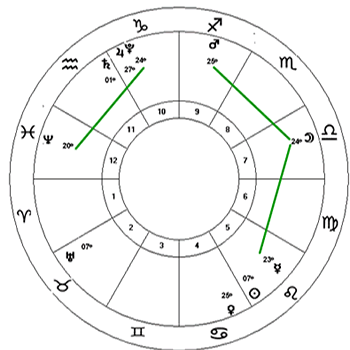

“It hasn’t the same effect the next morning, when I’m in a different head space,” a friend wrote to me recently. One of the aversions to a real conversation is how we might feel the next day: about things we expressed (expressing a feeling is a form of a commitment, which is why we might shy away from it), needs expressed (also a form of a commitment), or secrets revealed. These are all related topics - see if you can figure out the common thread. Saturn addresses boundaries, the ego structure, and our willingness to change. With Pluto this is about that delightful shadowy material of deep, dark eroticism, change, death and letting go, and our true emotional needs. Mercury trine anything opens the flow of communication (specifically) about the topic of the other planet involved. The astrology is pretty simple: trines open a flow. There is nothing like a trine from Mercury to Pluto - supported by Saturn - to help get the conversation going.

14.Dear Friend and Reader:We all know that we need to have more honest conversations about the important things in life - and we all know what they are. Saturn is at opposition to the sun on Aug. Venus will pass to the upper left of Saturn on the morning of March 29 and Saturn will appear quite close to Mars on the morning of April 4. The rings will turn edge-on to Earth during the spring of 2025.Īll through 2022, Saturn will be found within the boundaries of Capricornus the Sea Goat. They were at their maximum tilt toward Earth in October 2017 and are now closing to our line of sight, featuring an inclination of 17.6 degrees on New Year’s Day to 13.7 degrees by year’s end. The famous rings are visible only in a telescope. Saturn shines like a yellowish-white "star" of moderate brightness. The rings of Saturn and four of its moons take center stage in this portrait by the Hubble Space Telescope's Wide Field Camera 3, taken on June 20, 2019. Jupiter will appear quite close to Mars on the morning of May 29. Although Jupiter will glow with a lustrous magnitude of minus 2, Venus manages to outshine it by two magnitudes and appears more than six times brighter. Jupiter and Venus will rise side by side from above the eastern horizon on the morning of April 30 in an eye-catching sight. Jupiter is at opposition to the sun on Sept. 2, where it will remain for the balance of the year. The giant planet backtracks into Pisces on Sept.

Quite brilliant with a silver-white luster, Jupiter starts the year in Aquarius the Water Carrier, crosses over into Pisces the Fishes on April 14, then moves into the non-zodiacal constellation of Cetus, the Whale on June 26. Jupiter as seen by NASA’s Hubble Space Telescope on April 3, 2017, four days before the planet arrived at opposition.
MERCURY TRINE SATURN FULL
7, the full moon will pass exceedingly close above Mars, actually hiding it (called an occultation) for parts of North America, north of a line running from approximately San Antonio, to Frankfort, Kentucky to Kittery, Maine, no doubt evoking a question that will be repeated many times that night: "What is that bright yellow-orange star just below the moon?"įull moon calendar 2021: When to see the next full moon Jupiter It will then be shining at magnitude minus 1.9, outshining even Sirius, the brightest of all stars.ĭuring the evening hours of Dec. 8, rising as the sun sets, reaching its highest point in the sky at midnight and setting at sunrise. Mars will arrive at opposition to the sun on Dec. 30, at a distance of 50.6 million miles (81.4 million kilometers). Mars will be closest to the Earth on Nov. By the end of October, Mars will be shining at an eye-catching magnitude of minus 1.2 between the horns of Taurus, the Bull as it begins its retrograde motion. Mars will pass quite close to Saturn on the morning of April 4 and to Jupiter on the morning of May 29. As the year progresses, Mars will slowly increase in brightness as its distance from Earth gradually decreases.

Mars begins the year in the morning sky, shining as an inconspicuous second-magnitude object in the non-zodiacal constellation of Ophiuchus, the Serpent Holder. This particular aspect will be vividly demonstrated in 2022, with Mars increasing in brightness and luster some 23-fold from New Year’s Day to early December. Shining like a "star" with a yellow-orange hue, Mars can vary considerably in brightness. The Hubble Space Telescope captured this crystal-clear view of Mars and its two moons Phobos and Deimos.


 0 kommentar(er)
0 kommentar(er)
